Another squiggle, down this time, in moderate inflationary pressures that started a Year Ago.
By Wolf Richter for WOLF STREET.
Prices of used cars and trucks have been meandering higher unevenly since mid-2024, after the historic plunge that bottomed out in June 2024 had unwound over half of the pandemic spike. Used vehicle prices didn’t revert to the prepandemic mean, but stopped well short of that, and then began to rise again along a moderate but uneven inflationary trend. And July’s drop in wholesale prices is just another squiggle in that uneven inflationary trend.
Prices of used vehicles sold at auctions where franchised and independent dealers replenish their inventories dipped by 0.5% seasonally adjusted in July from June, undoing part of the price gain in the prior month (red line).
Not seasonally adjusted, prices fell by 1.4%, more than the normal price drop in July (blue line), according to today’s Used Vehicle Value Index data by Manheim, the largest auto auction house in the US. The index is adjusted for changes in mix and mileage.
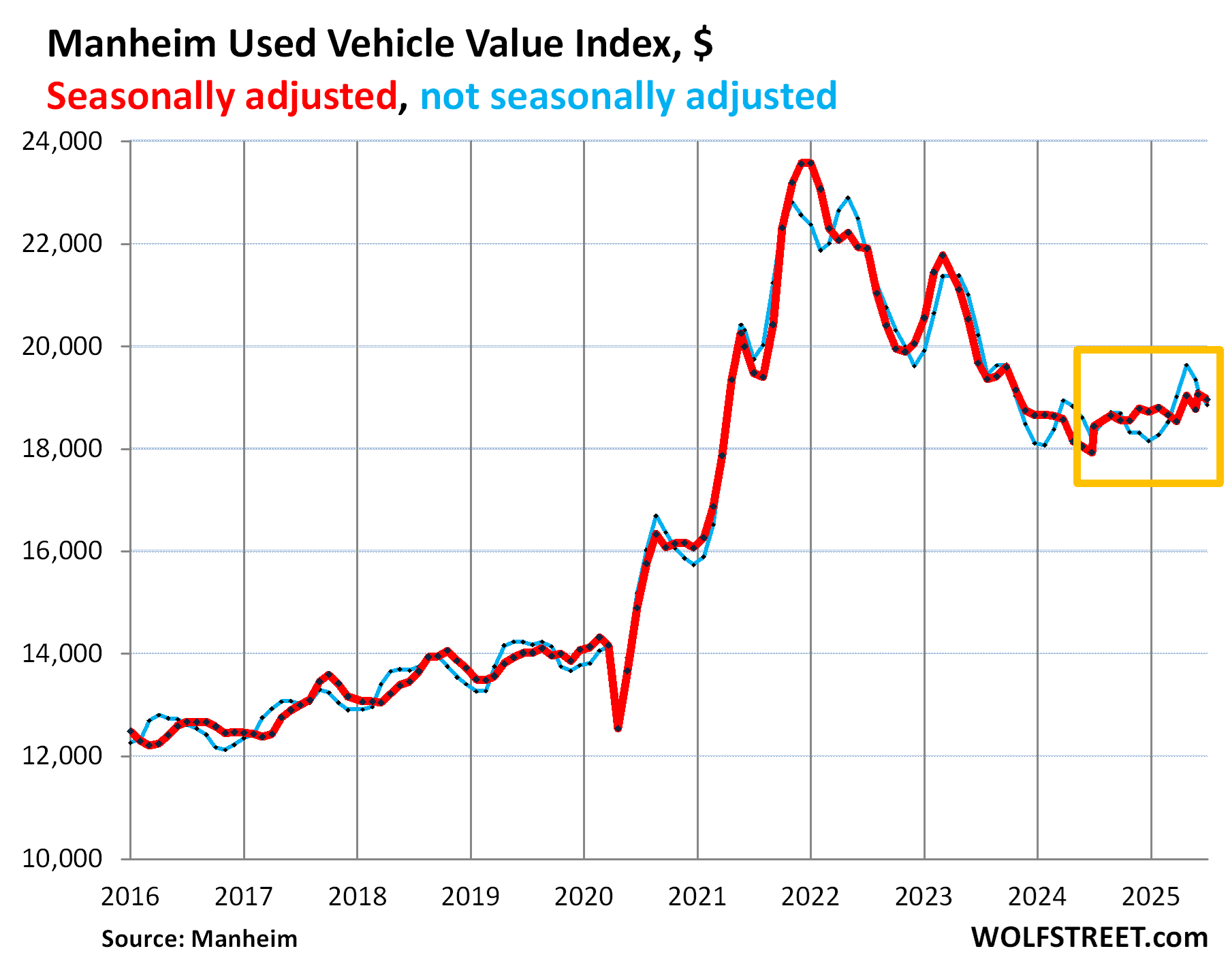
Supply at these auctions comes from rental fleets that sell vehicles they pulled out of service, from finance companies that sell their off-lease vehicles and repos, from corporate and government fleets, from other dealers, etc. These prices form the costs for dealers. Prices that consumers pay when they buy from dealers, as tracked by the used-vehicle CPI, follow these wholesale prices with a lag.
Year-over-year, not seasonally adjusted, the Used Vehicle Value Index rose by 3.0%. The index turned positive in December, and the last four months of increases (between 3% and 5%) were in the range of the prepandemic years.
Those were some crazy price increases back in 2021, topping out at over 50% year-over-year. The year-over-year price declines since mid-2022 were also historic: They were as deep as the biggest drops during the Financial Crisis, but lasted twice as long.
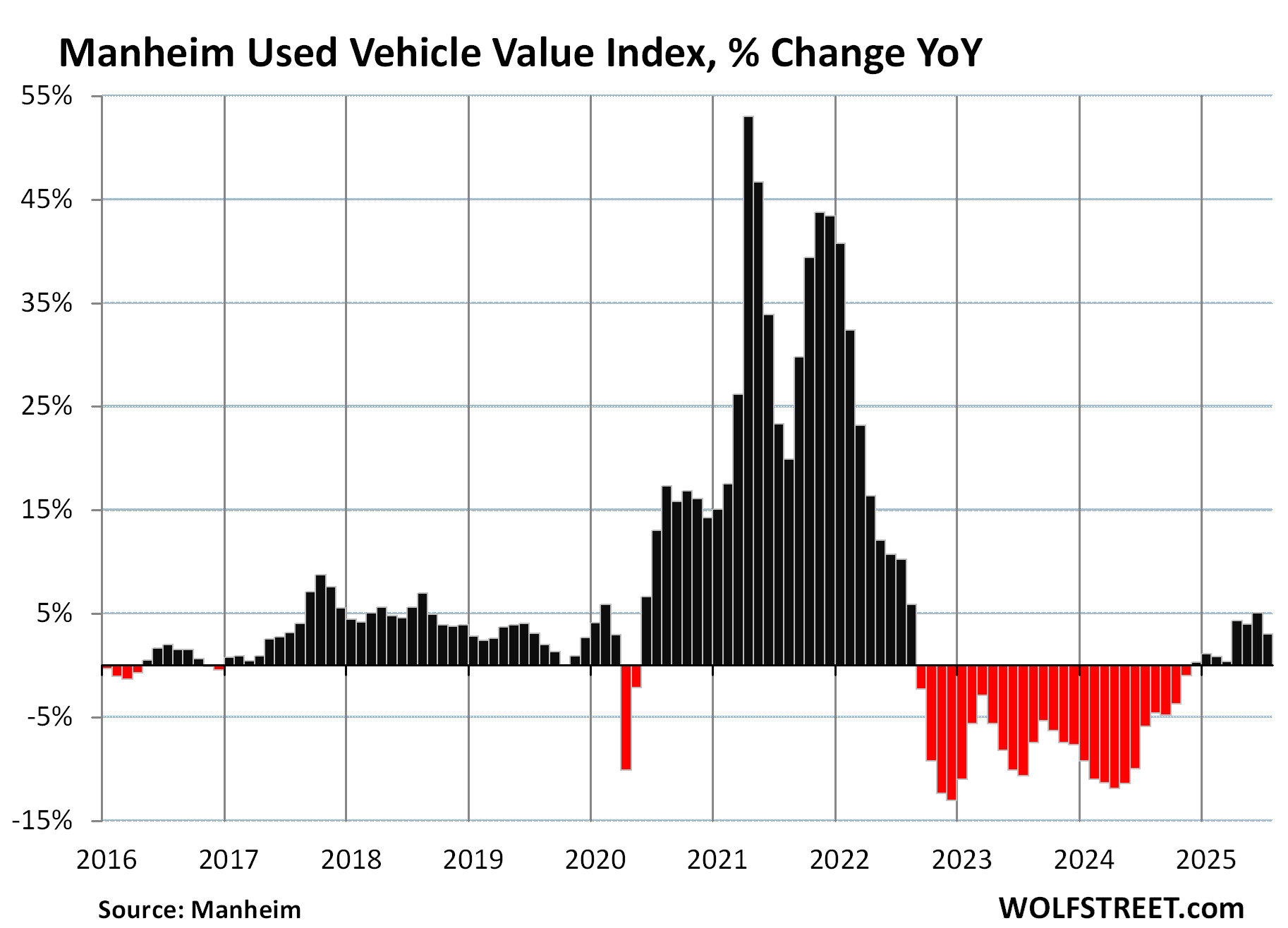
EVs created some of the price pressures since mid-2024.
Used EV prices have been rising for over a year. In July, they were up by 8.3% year-over-year, while ICE vehicle prices were up 2.4%.
Prices of ICE vehicles have been roughly stable since the end of 2023. But in EV prices, there was a lot more volatility.
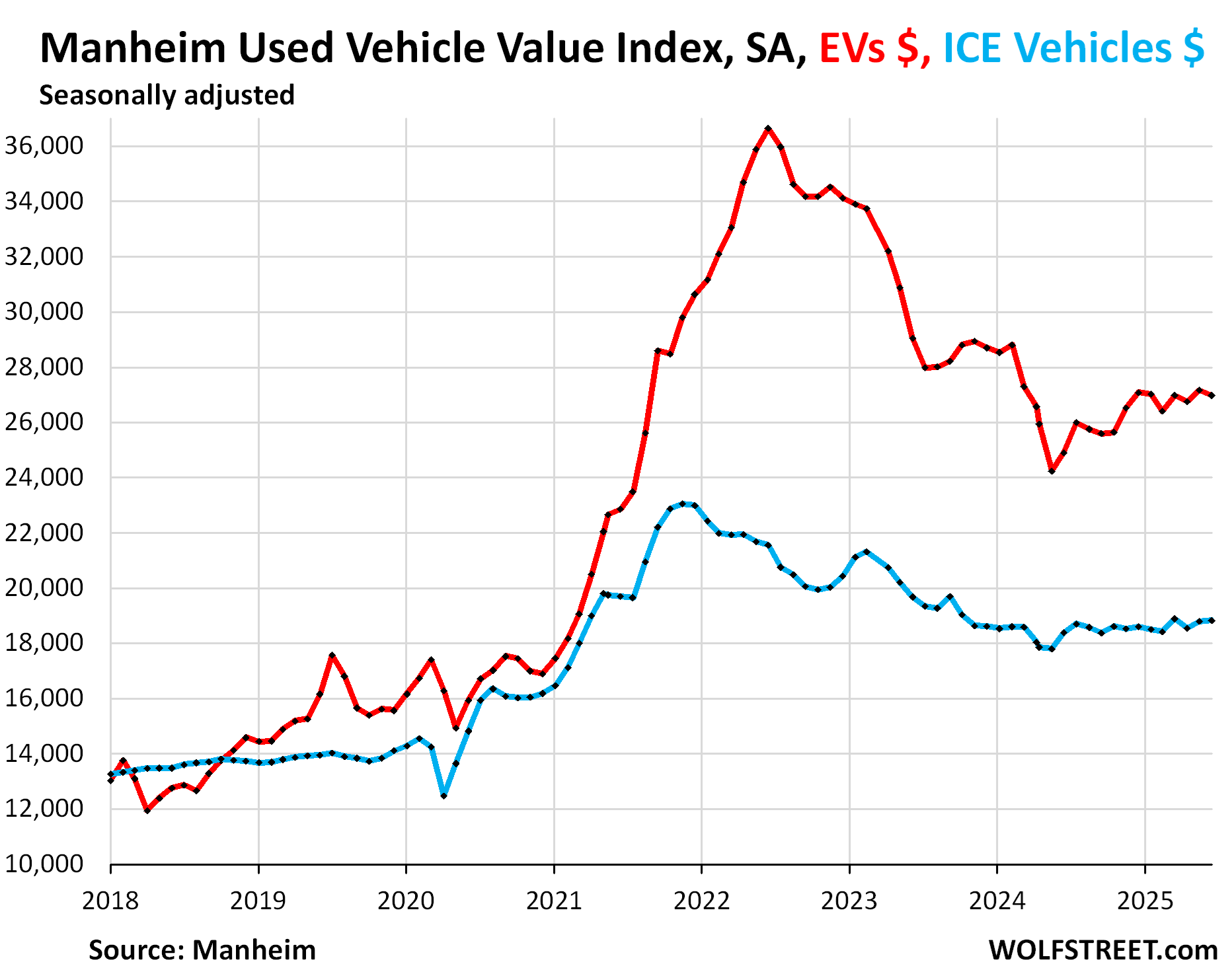
EVs are still a small but growing segment of the vehicles sold at these auctions. Most of the EV supply comes from lease returns and rental fleets.
EV prices had spiked ridiculously during the pandemic, when Tesla-flipping was a thing, with speculators buying new Teslas and reselling them as used for a big profit. That speculative behavior led to a crypto-like spike and plunge in prices. But today EV prices are still far higher than ICE vehicle prices, compared to their prepandemic relationship.
Solid demand, tight inventories.
“But both new and used retail sales have remained relatively healthy, and when you couple that with tighter inventory levels at Manheim, we generally have pretty solid demand at the auction,” Manheim said in the auction report.
In terms of retail, used vehicle sales have been running at a higher rate all year than in prior years, according to data from Cox Automotive through June. Manheim, a unit of Cox, reported that preliminary data indicates that July retail used-vehicle sales were also solid, and up sequentially from June.
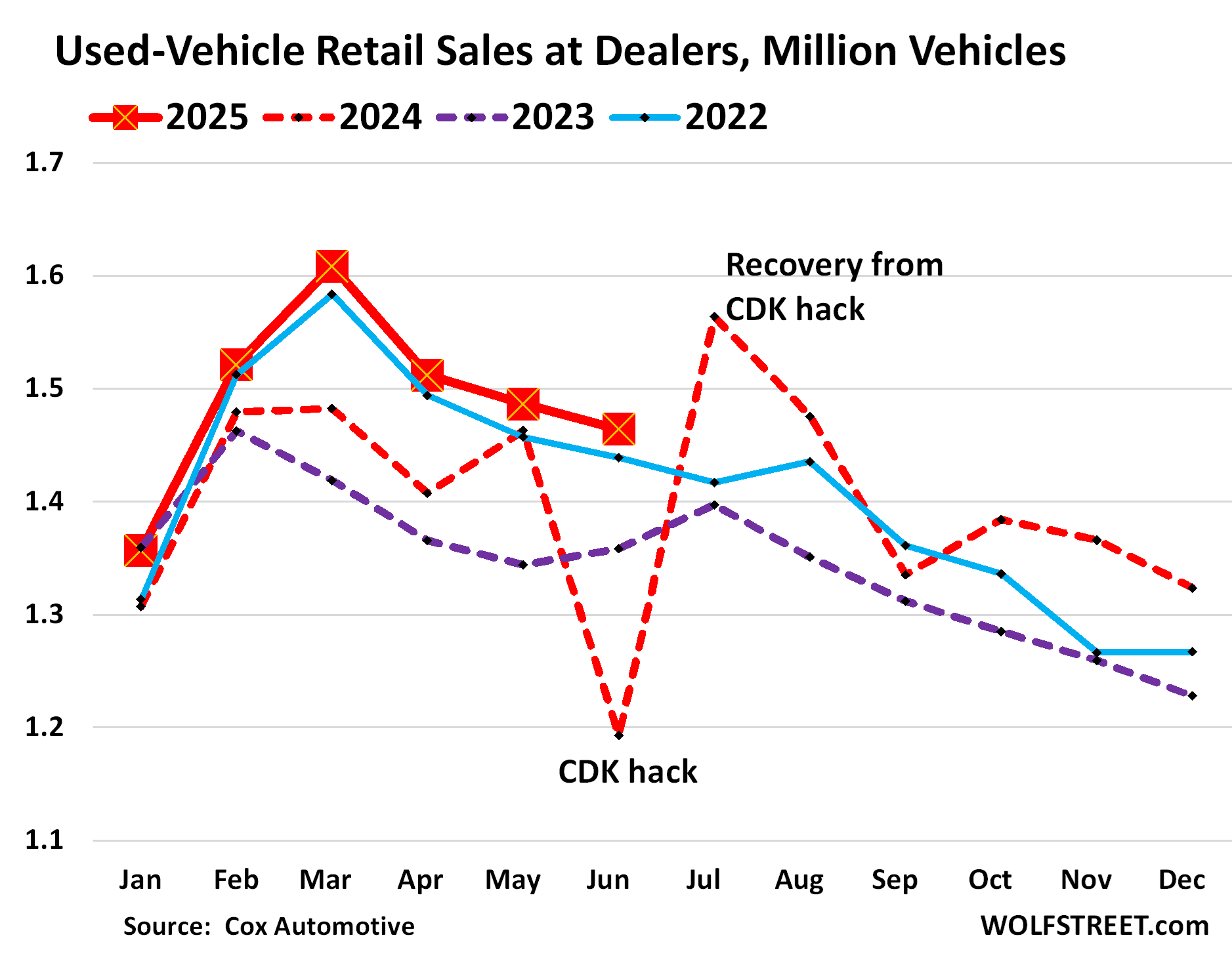
The gyrations in June and July 2024 (red dotted line above) were caused by the hack of CDK’s cloud-based dealership management software. CDK shut down the system in June 2024, and dealers had trouble getting anything done, including processing deals. So sales plunged in June 2024, and then in July, the system came back online, and dealers caught up processing deals.
Retail inventories at used-vehicle dealers at the end of June (latest data available from Cox Automotive), at 2.21 million units, was down a hair from a year ago amid higher sales, and was down by about 19% from the same period in 2019.
This tight supply is largely a result of the production shutdowns in 2021 and 2022 of new vehicles that deprived the US market of millions of new vehicles that are now not flowing into the used vehicle market.
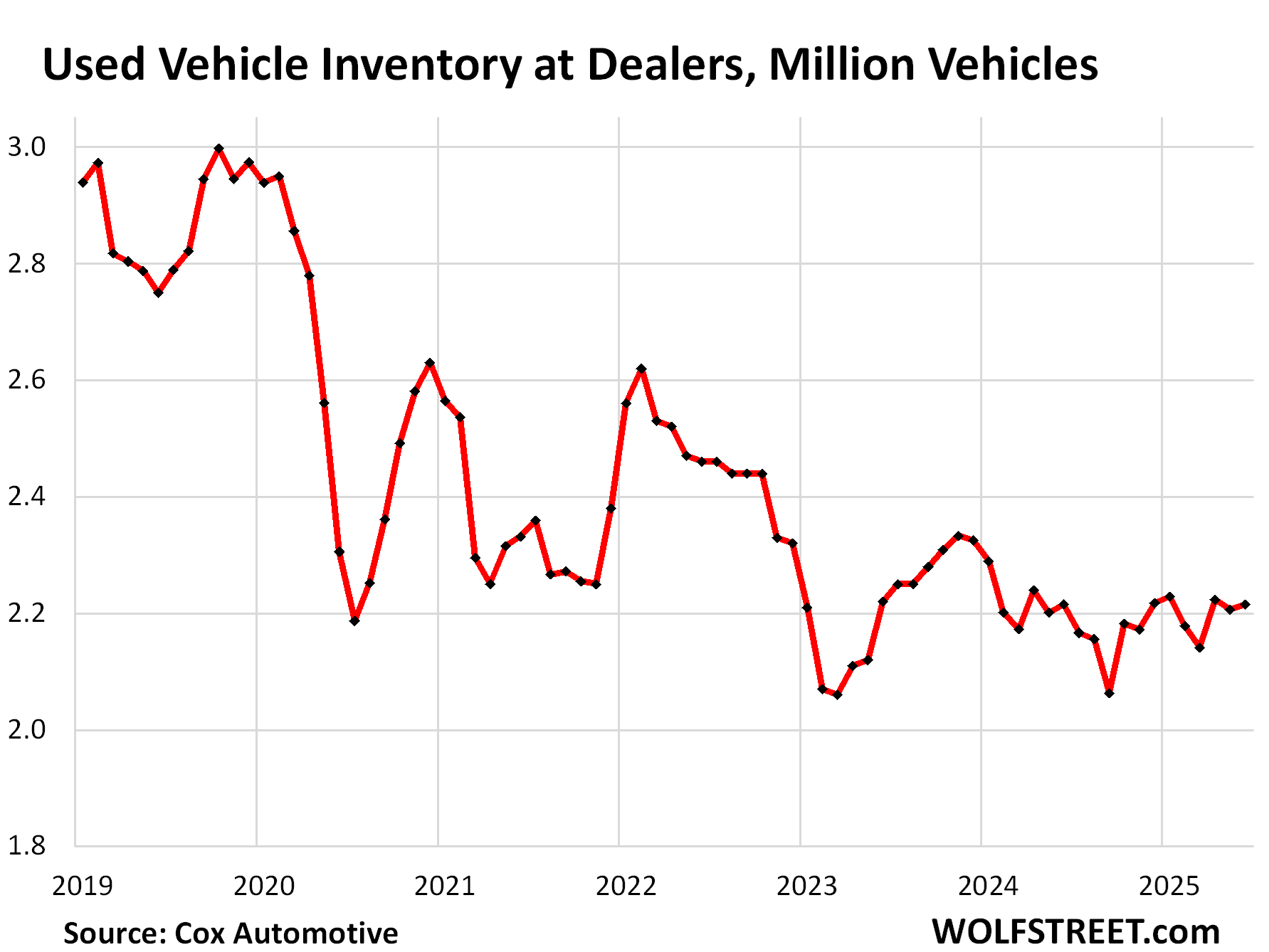
Enjoy reading WOLF STREET and want to support it? You can donate. I appreciate it immensely. Click on the mug to find out how:
![]()


There is a very nice used Blu Elettrico 2014 Ferrari LaFerrari on BAT and it is now at only $4.2 million with 17 bids and less than a day to go.
That’s the value of an entire inventory of a used-vehicle dealer with 220 vehicles on the lot, averaging $15,000.
Wolf, do you have that chart available of the auto makers profit margins posted from a few articles back? Was digging around for it and can’t seem to find it. The one where they were crying about shrinking profit margins but you had showed they were still up astronomically compared to 2019-2020? Was having a conversation with a friend about them and he wasn’t believing it.
And yes, the market is still high for used cars. Even the Porsche 911 market has been taking a hit, yet sellers are still asking beer flu prices and getting laughed off the forums/ FB marketplace.
That chart was for retailers overall, see below, which includes auto dealers. I don’t have separate data for auto dealers. J.D. Power reports monthly figures of dealer profits. And I look at them (they were shocking during the pandemic, as you probably know), but I don’t have a time series of data. I might ask J.D. Power for it. They’ve made some other data available to me, so I’ll try.
Prices of used car parts have started to accelerate
https://fred.stlouisfed.org/series/CUUR0000SETC
Yeah, they’re up 2.3% YoY, less than used cars, les than overall CPI inflation, less than food inflation, a lot less than services CPI, less than a lot of stuff.
If it stays flat for 3 years or so, we’ll be back on the pre-Covid trend.
I calculate about two years to get back to trendline from 2016 to 2020. I agree current numbers are not too far from the trendline pre-covid
Apparently, Japanese auto tariffs were miscalculated with stacked rates, and Japan wasn’t happy, but guess it’s straightened out? I guess this is near the final stages of negotiation frameworks – pretend there’s a deal, then see if you can still screw them?
“Lutnick and Bessent said Trump would at the same time lower auto tariffs to 15% from 27.5%, in line with the agreement on trade reached by the two countries last month”